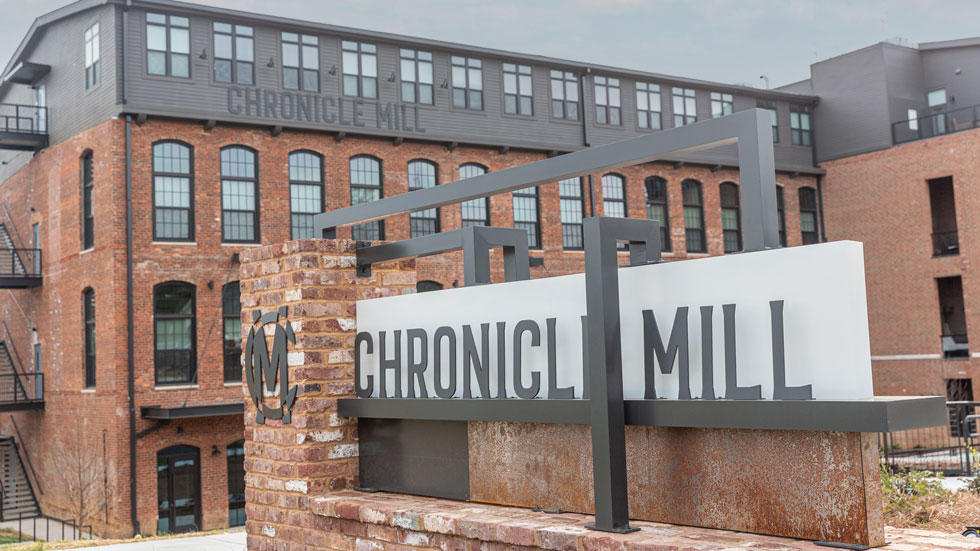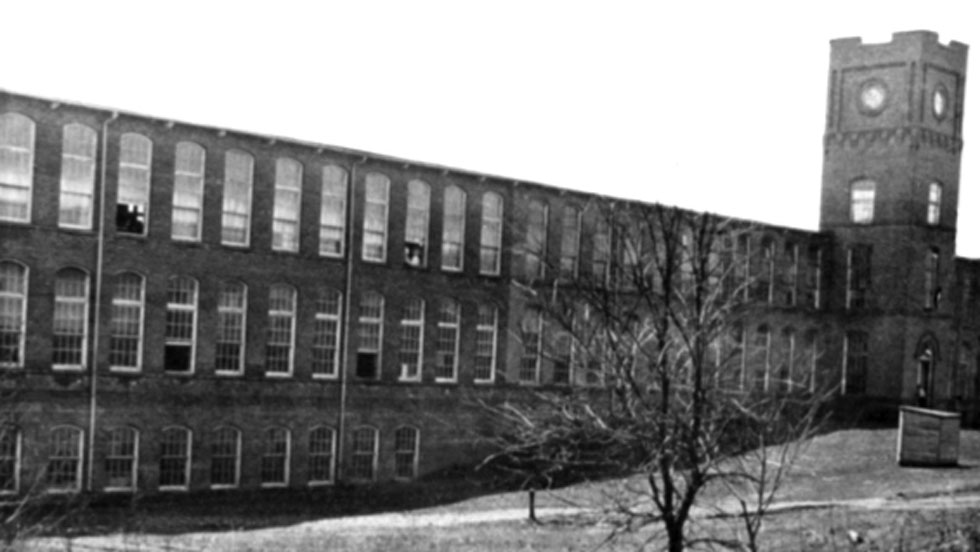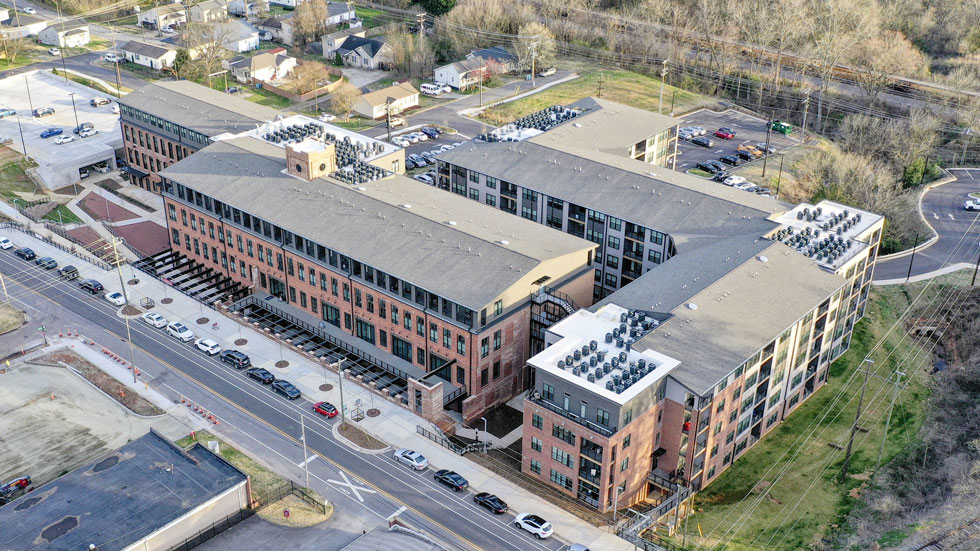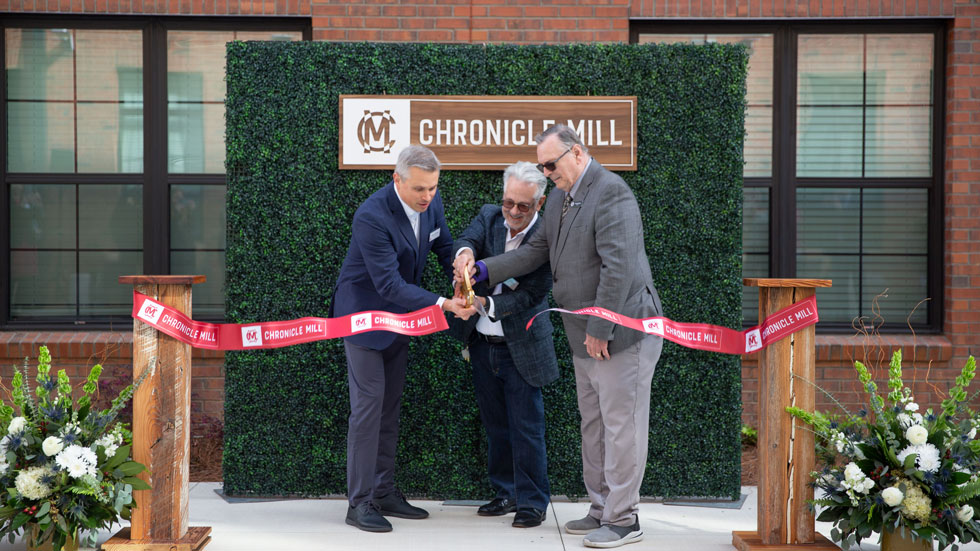A former textile mill that produced its last skein of yarn in 2010, and narrowly escaped demolition, has been restored through a partnership with Armada Hoffler Properties Inc. (NYSE: AHH) into a mixed-use development that retains an important part of a town’s history and shows how to create much-needed housing in growing markets through creative and environmentally friendly adaptive re-use.
John and Jennifer Church, owners of Centra Properties, a commercial real estate company based in Belmont, North Carolina, purchased Chronicle Mill in 2013. “Our goal initially was to tear down the 110,000 square foot, 120-year-old textile building and sell the seven acres,” says John Church.
However, as the demolition started, “we realized the potential of redeveloping this beautiful historic property as a re-imagined mixed-use addition to complement the revitalizing downtown Belmont. The value that could be created by continuing its legacy within the community became our primary goal,” he adds.
Ten years later, with a partnership with Virginia Beach, Virginia-based Armada Hoffler, the Churchs’ vision was realized.
“We’re really proud of this project because the mill was a staple of the community for more than 120 years,” says Shawn Tibbetts, COO of Armada Hoffler. “We met so many people in Belmont with family members who had worked in the mill who were excited that we were breathing new life into it.”
The Churchs struggled for years to overcome the challenges of a complex adaptive reuse of a historic property. They brought in Armada Hoffler as a partner in 2018. “Finding the right development partner with the capacity, expertise, and experience to redevelop an historic downtown property was the biggest challenge,” says Church. “The process to redevelop the project with a brownfield agreement, zoning restrictions, intrusive utility easements, and procuring entitlements was complicated.”
While adaptive reuse isn’t the core of Armada Hoffler’s business, the company has successfully executed adaptive reuse before, such as the conversion of an office to a multifamily and retail development at The Edison in Richmond, Virginia.
“For Chronicle Mill, the project was a marriage of our capabilities and availability of capital with the local knowledge in Belmont,” Tibbetts says. “Our philosophy is that we can’t be experts at everything, so we team with people who know their local market. The Churchs were effective with local officials, and we were effective with our capital raise, risk management, and execution.”
Saving and Revitalizing a Historic Asset
When the Churchs contacted Armada Hoffler, the company immediately recognized the value of the town of Belmont, located about 14 miles outside of Charlotte, North Carolina.
“Belmont is within the commuting orbit of Charlotte and yet it has a quaint small town feel,” Tibbetts says. “It’s missing high-end residential rentals, so that was an opportunity for us.”
At the same time, local leaders hoped to preserve their history while becoming more attractive to commuters. Chronicle Mill was one of multiple textile facilities that closed in the region as the textile industry slowed and moved overseas, says Donny Hicks, executive director of the Gaston County, North Carolina Economic Development Commission.
“We’ve lost millions of square feet and lots of history when many of them were razed,” Hicks says. “This project, especially because of its proximity to Charlotte, offered an opportunity to push the rent a little and attract young professionals to Belmont. We wanted to demonstrate the market for this type of product.”
Chronicle Mill, which has 244 apartments, achieved stabilization within six months instead of the anticipated 18 months, Tibbetts says. In addition to the apartments, Chronicle Mill has two live-work units and 9,000 square feet of retail space.
“The live-work units are two-level spaces with the lower-level living area facing a garden and the work area on the street level to provide visibility for the business,” Tibbetts says. “We think they’re a great opportunity for someone to grow their business.”
Armada Hoffler anticipates the retail space will include a small fast casual restaurant, a brewery, and a yoga studio or similar businesses.
“We like energetic businesses that are likely to appeal to residents in the building and function as building amenities, as well as to appeal to neighbors,” Tibbetts says. “The mixed uses of the building make it a stronger asset, plus this building is located within walking distance of Belmont’s downtown.”
The area near Chronicle Mill offers good density to support retail, Hicks says. “You also have some great single-family homes left behind by mill owners in the area that sell for $1 million to $1.5 million,” Hicks says. “Belmont gets good foot traffic because its walkable to many neighborhoods and people like the authentic feel of this 100-year-old town.”
Hicks says that Belmont residents are proud of their history in the textile industry.
“Chronicle Mill ties us back to the past and links us to the future growth in this area,” he says.
Challenges of Adaptive Reuse
As with any adaptive reuse project, there were construction and infrastructure challenges with Chronicle Mill.
“Making a mill into residences is like putting a square peg into a round hole,” Tibbetts says. “On top of that, this project was executed during the pandemic, so we had to deal with materials and construction pricing that were unstable and climbing.”
The 120-year-old mill had to be stripped down and reinforced to handle its new function, Tibbetts says. “We wanted to preserve the beauty of the old wood and the brick in the existing walls, but we also had to integrate new and efficient systems into the mill,” he says. “Every corner has a surprise when you’re doing adaptive reuse.”
Tibbetts credits their in-house construction and development team with mitigating risk by restabilizing the foundation and restoring as much as possible of the pre-existing elements.
“Part of our strategy is to build a better-quality product by getting the property at a better acquisition cost,” Tibbetts says. “Probably the biggest challenge was getting the electrical and plumbing conduits through the pre-existing structure without impacting its integrity.”
Infrastructure issues were also obstacles to overcome. “They had to work around the power grid that fed the mill and relocate utilities,” Hicks says. “And as with any project now, we had to do a traffic study and figure out parking. Armada Hoffler was able to take advantage of the topography of the site to add a one-story parking deck.”
To assist in these challenges, Armada Hoffler was able to use state tax credits and funds for mill renovations and brownfield redevelopment tax credits, Hicks says. In addition, both the city of Belmont and Gaston County provided incentives to move the Chronicle Mill project forward.
“The excitement of the city and county officials about this project made it easier to get all the stakeholders going in the same direction,” Tibbetts says. “There were some concerns about the parking and the impact on the surrounding residential neighborhoods, but overall, everyone in the area shared the same objective.”
Adaptive Reuse as Catalyst for Development
Every adaptive reuse project requires a business case, Tibbetts says. “The demographics showed that this market needed this type of housing because Charlotte has been growing so quickly, especially post-Covid,” he says. “There’s a market here for young professionals who want to live close to Charlotte but want a slower pace of life.”
The rapid run-up in apartment rents during the period when Armada Hoffler was remodeling Chronicle Mill easily offset the construction cost increases they faced, Tibbetts says. “It helped that we got to know Belmont, how Chronicle Mill fits into the community and to have the support of the city, county, and constituents,” Tibbetts says. “That helped us get the right elements of the culture integrated into the project. With the success of this project, we were able to show others the market fundamentals in this submarket.”
For Hicks, Chronicle Mill’s fast lease-up provided proof that a market exists for higher-end multifamily communities in Gaston County. He says several more adaptive reuse projects are on the way in the county.
“It has been a pleasure to see Chronicle Mill reactivated in downtown Belmont, where it will be part of this community for many generations to come,” Church says. “So many hands have contributed to this development along the way. The story of Chronicle Mill is a perfect example of how a community comes together to build an enterprise that lasts well beyond what the original creators envisioned.”



